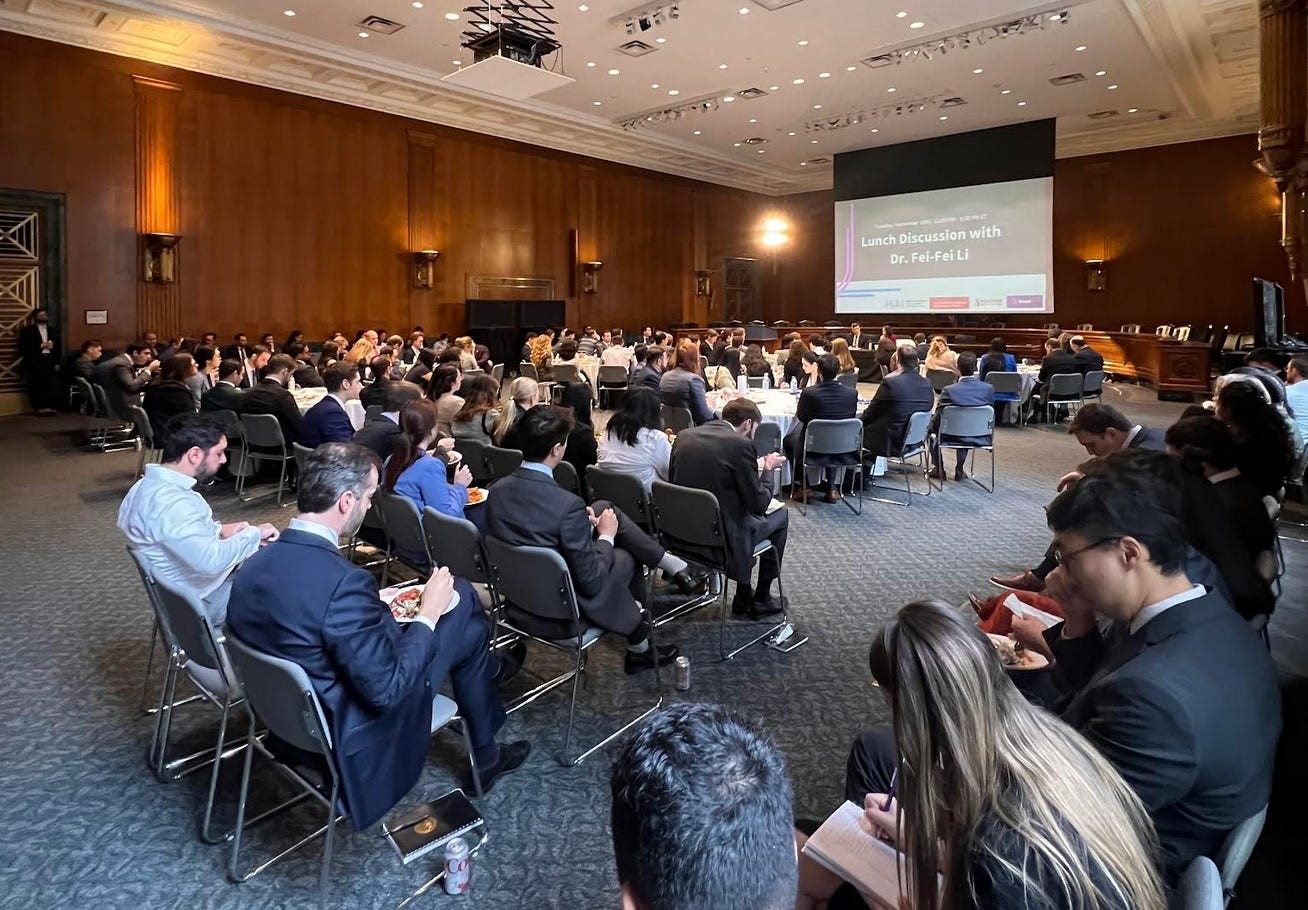The essentials
- Universities lack AI resources. Stanford University leaders emphasize that academia cannot compete with private companies in AI research due to limited access to GPUs and funding.
- Empire AI Coalition Offers a Glimmer of Hope. A New York-based coalition is pooling resources to create a shared AI computing center for academic research.
- Government action could level the playing field. The proposed “Create AI” bill seeks federal funding to provide universities with shared resources for large-scale AI experiments.
Stanford University has 300 GPUs. Microsoft will have 1.8 million. Here’s what’s needed to make academia relevant in AI research.
Last Tuesday, before a packed room inside the Dirksen Senate Office Building in Washington, D.C., leaders of the Stanford Institute for Human-centered AI made a plea.
Co-director Fei-Fei Li and executive director Russell Wald told the roughly 200 assembled members of Congress that today’s universities simply do not have the resources to conduct fundamental research in generative AI. Chips, data centers and energy costs do not fit into university budgets. And they need serious help.
Universities struggle to compete in AI research
“All the universities in America combined couldn’t create a version of ChatGPT right now,” Wald told me. “It’s quite problematic.”
The dire situation is reaching a boiling point. Microsoft aims to have 1.8 million GPUs by the end of next month while Stanford University has around 300 of these chips, which are the essential components for testing and training generative AI.
Related article: Decoding the differences between traditional AI and generative AI in marketing
Private sector versus academia: the growing divide
Wald then cited startling statistics showing how far universities have fallen behind the private sector in an area where they previously led.
In 2022, Wald said, 22 significant AI breakthroughs came from industry, compared to just three from academia. By 2011, approximately equal numbers of PhDs in AI would be heading to the private sector and academia. Today, 70% of them are in the private sector, he said. Professors and graduate students interested in conducting cutting-edge research also have difficulty choosing universities because available resources do not allow them to do this work.
“This is very concerning about the future of the technology,” Wald said, “because it begs the question: Does the academy have a place in cutting-edge AI research? At HAI , we would say yes.
University technology research, Wald said, is necessary because it is freed from the intense product-oriented work done inside companies, which helps it spark fundamental advances like GPS, MRI and the Internet.
“These are things that no investor would ever invest in because they would see no return on investment,” he said. “They would be dead by the time they got a real profitable margin out of it.”
The role of academia in advancing technology
Wald also noted that academic AI research can help train regulators to understand AI, so that knowledge extends beyond that of the companies themselves.
And it can serve the public good by releasing open source research and models given that companies like OpenAI and Google have stopped sharing their cutting-edge research as the field has become ultra-competitive.
What are the solutions?

Universities are therefore currently facing a serious AI resource problem. In addition to not having the money to invest in AI data centers (a NVIDIA GPU can cost up to $40,000 per chip), they face difficulty setting up facilities with enough space and cooling capacity to operate. And energy costs add up too.
But faced with the problem, some academic institutions like Stanford and a new group in New York are fighting to solve it.
Empire AI: a collaborative step forward
In New York, a unique coalition of universities, government and private philanthropies has just built an artificial intelligence computing center whose experiments began last week. The initiative, called Empire AI, is created as a shared resource at the University at Buffalo and includes NYU, Cornell, Columbia, RPI, SUNY and CUNY. The group received a GPU donation from the Simons Foundation and support from Empire State Development.
“We are just testing Empire AI; we are starting to execute the first works,” said Stacie Grossman Bloom, NYUdirector of research, vice-rector and vice-chancellor for global research and innovation.
NYU researchers are already using the machine to detect deep fakes. The university, Grossman Bloom said, has received 19 work order requests, with more to come. “The idea is that the machine does not remain idle at all. But to really make it work, you have to run it hard and run it at full capacity,” she said.
Empire AI currently has 96 NVIDIA H100 GPUs which, even at a multi-million dollar value, don’t come close to what companies like Amazon, xAI, Meta, Microsoft, OpenAI use to build, query and run their models. But the coalition plans to significantly expand the compute resources within Empire AI as it moves beyond its “alpha” phase.
Ultimately, such initiatives won’t allow universities to conduct basic research without a massive increase in resources – and that’s where the federal government could step in.
Related article: Facing AI and Inequality in the Age of Big Tech
The Create AI Act: a solution on the horizon
Stanford’s Wald and Li were in Washington to advocate for Congress to pass the “Create an AI”, a bill that would make permanent a shared resource that would enable large-scale AI research. This “national artificial intelligence research resource,” which has a pilot project established by the Biden administration by executive order, would make computing and data sets available to universities and students to conduct artificial intelligence experiments. ‘AI.
The U.S. government and corporate partners like NVIDIA and Microsoft have already invested tens of millions of dollars in the project, but the bill would establish it in law and help it be funded with appropriations from the federal government, through the National Science Foundation. The amount of funding currently being discussed in Congress is about $400 million to $500 million per year, Wald said, over a six-year period. If passed, this bill would be a paradigm shift.
A race against time in Congress
Wald said he and Li arranged last week’s meeting with congressional staffers last Friday. Initially, only ten registrations came in and they started to worry. But the event became so popular that a queue formed around the venue as people rushed to get in.
The Create AI bill is gaining momentum in Congress today. There is bipartisan support in both chambers. Seventy-eight companies, universities and institutions, from Princeton to Google, alone wrote to management last week support him. And it could pass during the lame duck session.
But Wald said the bill’s fate depends on whether lawmakers decide to implement it during a busy period, which would effectively give it a six-week deadline before Congress returns.
“It’s probably one of the easiest things to adopt in any AI program,” Wald said.
And now the only question is whether the will is there to do it.
Find out how you can join our community of contributors.


